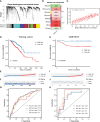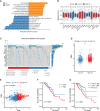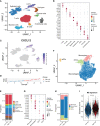Integrative multi-omics analyses unravel the immunological implication and prognostic significance of CXCL12 in breast cancer
- PMID: 37564657
- PMCID: PMC10410148
- DOI: 10.3389/fimmu.2023.1188351
Integrative multi-omics analyses unravel the immunological implication and prognostic significance of CXCL12 in breast cancer
Abstract
Background: CXCL12 is a vital factor in physiological and pathological processes, by inducing migration of multiple cells. We aimed to comprehensively detect the role of CXCL12 in breast cancer, and explore novel CXCL12-related biomarkers through integrative multi-omics analyses to build a powerful prognostic model for breast cancer patients.
Methods: Immunohistochemistry analysis of the tissue microarray was performed to evaluate the correlation between CXCL12 expression levels and breast cancer patient outcomes. Combined single-nucleus and spatial transcriptomics data was used to uncover the expression distribution of CXCL12 in breast cancer microenvironment. CXCL12-related genes were identified by WGCNA analysis. Univariate Cox and LASSO regression analyses were then conducted to screen prognostic genes from above CXCL12-related genes, followed by the construction of the CXCL12-related prognostic signature, identification of risk groups, and external validation of the prognostic signature. Analyses of biological function, mutation landscape, immune checkpoint genes and immune cells, were performed to further reveal the differences between high/low-risk groups. Paired single-cell RNA-seq and bulk RNA-seq were analyzed to further disclose the association between the risk score and the complex tumor immune microenvironment. To screen potential therapeutic agents for breast cancer patients, analyses of gene-drug correlation and sensitivity to immunotherapy were conducted.
Results: High expression of CXCL12 was linked with a prolonged survival in breast cancer. A total of 402 genes were identified by WGCNA analysis and 11 genes, covering VAT1L, TMEM92, SDC1, RORB, PCSK9, NRN1, NACAD, JPH3, GJA1, BMP8B and ADAMTS2, were screened as the candidate prognostic genes. Next, the prognostic signature was built and validated using these genes to predict the outcomes of breast cancers. The high-risk group patients exhibited significantly inferior prognoses. The combination of the risk score and tumor mutational burden (TMB) had remarkably improved performance in predicting patient outcomes. Besides, high-risk group patients showed higher infiltration of M2-like macrophages. Finally, several potential anticancer drugs were identified. The high-risk group patients were more sensitive to immunotherapy but resistant to docetaxel.
Conclusions: CXCL12 has important immunological implication and prognostic significance in breast cancer. The CXCL12-related prognostic model could well predict the prognosis and treatment response of breast cancers.
Keywords: CXCL12; breast cancer; drug screening; immune landscape; prognostic signature; single-cell RNA-seq.
Copyright © 2023 Gao, Fang, Yuan, Sun and Li.
Conflict of interest statement
The authors declare that the research was conducted in the absence of any commercial or financial relationships that could be construed as a potential conflict of interest.
Figures








Similar articles
-
Cancer-associated fibroblast-derived gene signature discriminates distinct prognoses by integrated single-cell and bulk RNA-seq analyses in breast cancer.Aging (Albany NY). 2024 May 9;16(9):8279-8305. doi: 10.18632/aging.205817. Epub 2024 May 9. Aging (Albany NY). 2024. PMID: 38728370 Free PMC article.
-
M2-like tumor-associated macrophage-related biomarkers to construct a novel prognostic signature, reveal the immune landscape, and screen drugs in hepatocellular carcinoma.Front Immunol. 2022 Sep 13;13:994019. doi: 10.3389/fimmu.2022.994019. eCollection 2022. Front Immunol. 2022. PMID: 36177006 Free PMC article.
-
Multi-omics analysis revealing a senescence-relevant lncRNAs signature for the assessment of response to immunotherapy for breast cancer.Medicine (Baltimore). 2023 Jul 14;102(28):e34287. doi: 10.1097/MD.0000000000034287. Medicine (Baltimore). 2023. PMID: 37443486 Free PMC article.
-
Unveiling the novel immune and molecular signatures of ovarian cancer: insights and innovations from single-cell sequencing.Front Immunol. 2023 Nov 1;14:1288027. doi: 10.3389/fimmu.2023.1288027. eCollection 2023. Front Immunol. 2023. PMID: 38022625 Free PMC article. Review.
-
Single‑cell multi‑omics advances in lymphoma research (Review).Oncol Rep. 2023 Oct;50(4):184. doi: 10.3892/or.2023.8621. Epub 2023 Aug 24. Oncol Rep. 2023. PMID: 37615192 Review.
Cited by
-
ADAMTS2: More than a procollagen N-proteinase.Genes Dis. 2025 May 13;12(6):101686. doi: 10.1016/j.gendis.2025.101686. eCollection 2025 Nov. Genes Dis. 2025. PMID: 40837410 Free PMC article. Review.
-
DDIT3 is associated with breast cancer prognosis and immune microenvironment: an integrative bioinformatic and immunohistochemical analysis.J Cancer. 2024 May 28;15(12):3873-3889. doi: 10.7150/jca.96491. eCollection 2024. J Cancer. 2024. PMID: 38911383 Free PMC article.
-
Cancer-associated fibroblast-derived gene signature discriminates distinct prognoses by integrated single-cell and bulk RNA-seq analyses in breast cancer.Aging (Albany NY). 2024 May 9;16(9):8279-8305. doi: 10.18632/aging.205817. Epub 2024 May 9. Aging (Albany NY). 2024. PMID: 38728370 Free PMC article.
-
Construction of a prognostic risk model for clear cell renal cell carcinomas based on centrosome amplification-related genes.Mol Genet Genomics. 2025 Mar 13;300(1):30. doi: 10.1007/s00438-025-02237-7. Mol Genet Genomics. 2025. PMID: 40075035 Free PMC article.
-
PCSK9 Manipulates Lipid Metabolism and the Immune Microenvironment in Cancer.Onco Targets Ther. 2025 Mar 27;18:411-427. doi: 10.2147/OTT.S504637. eCollection 2025. Onco Targets Ther. 2025. PMID: 40166624 Free PMC article. Review.
References
MeSH terms
Substances
LinkOut - more resources
Full Text Sources
Medical
Miscellaneous

